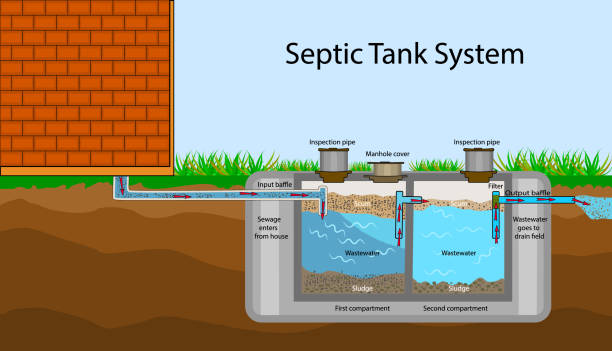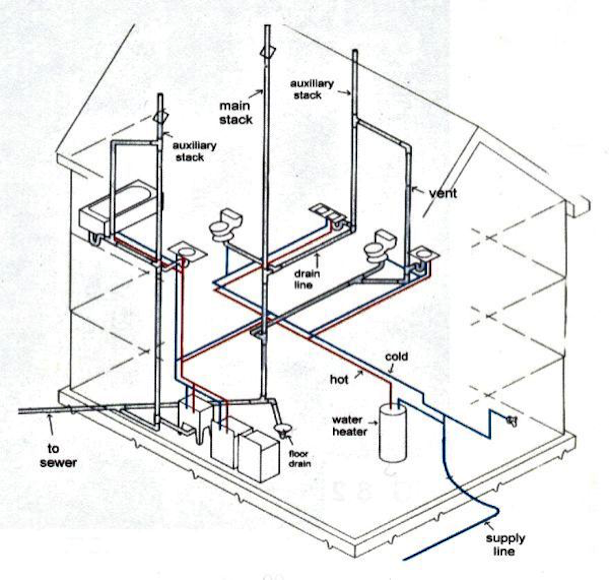The Core Elements of Your Home's Plumbing System
The Core Elements of Your Home's Plumbing System
Blog Article
Just how do you really feel about The Inner Workings of Your Home's Plumbing?

Recognizing exactly how your home's plumbing system works is vital for every single home owner. From supplying tidy water for alcohol consumption, food preparation, and showering to securely eliminating wastewater, a well-kept pipes system is vital for your household's health and wellness and comfort. In this extensive guide, we'll explore the elaborate network that makes up your home's pipes and deal ideas on maintenance, upgrades, and dealing with common issues.
Intro
Your home's pipes system is more than just a network of pipelines; it's an intricate system that ensures you have access to clean water and reliable wastewater elimination. Understanding its components and just how they collaborate can aid you stop expensive repair work and ensure every little thing runs smoothly.
Basic Elements of a Plumbing System
Pipelines and Tubing
At the heart of your plumbing system are the pipelines and tubing that lug water throughout your home. These can be made of various products such as copper, PVC, or PEX, each with its advantages in regards to sturdiness and cost-effectiveness.
Components: Sinks, Toilets, Showers, and so on.
Fixtures like sinks, toilets, showers, and bathtubs are where water is utilized in your house. Comprehending just how these components connect to the pipes system aids in diagnosing issues and planning upgrades.
Valves and Shut-off Points
Shutoffs regulate the flow of water in your pipes system. Shut-off shutoffs are essential throughout emergency situations or when you require to make repair work, enabling you to separate parts of the system without disrupting water flow to the whole home.
Water Supply System
Main Water Line
The primary water line attaches your home to the municipal supply of water or an exclusive well. It's where water enters your home and is dispersed to various fixtures.
Water Meter and Stress Regulatory Authority
The water meter actions your water usage, while a pressure regulatory authority guarantees that water streams at a secure stress throughout your home's pipes system, preventing damage to pipelines and fixtures.
Cold Water vs. Hot Water Lines
Recognizing the distinction between cold water lines, which provide water straight from the main, and hot water lines, which lug heated water from the water heater, assists in repairing and preparing for upgrades.
Drainage System
Drain Pipes Pipes and Traps
Drain pipes bring wastewater far from sinks, showers, and bathrooms to the sewage system or septic tank. Traps stop sewage system gases from entering your home and also trap particles that can cause clogs.
Ventilation Pipelines
Air flow pipes permit air into the drainage system, avoiding suction that might reduce water drainage and create traps to empty. Appropriate air flow is crucial for maintaining the integrity of your plumbing system.
Significance of Appropriate Drainage
Ensuring correct drain avoids back-ups and water damages. Regularly cleaning drains and maintaining traps can prevent costly repair services and expand the life of your pipes system.
Water Furnace
Sorts Of Water Heaters
Hot water heater can be tankless or conventional tank-style. Tankless heating units warm water on demand, while storage tanks store heated water for prompt usage.
Exactly How Water Heaters Link to the Plumbing System
Understanding how water heaters connect to both the cold water supply and hot water distribution lines aids in detecting problems like inadequate hot water or leaks.
Maintenance Tips for Water Heaters
Routinely flushing your hot water heater to eliminate sediment, checking the temperature setups, and checking for leaks can extend its life-span and enhance energy effectiveness.
Common Pipes Problems
Leaks and Their Reasons
Leakages can occur due to maturing pipelines, loose installations, or high water pressure. Addressing leakages without delay stops water damage and mold and mildew growth.
Clogs and Clogs
Blockages in drains and toilets are frequently caused by flushing non-flushable things or an accumulation of grease and hair. Making use of drainpipe screens and bearing in mind what goes down your drains pipes can avoid obstructions.
Indicators of Plumbing Troubles to Watch For
Low tide pressure, slow-moving drains, foul odors, or abnormally high water expenses are signs of prospective plumbing issues that need to be attended to promptly.
Plumbing Upkeep Tips
Routine Examinations and Checks
Arrange yearly plumbing assessments to catch concerns early. Search for indicators of leaks, rust, or mineral accumulation in taps and showerheads.
Do It Yourself Maintenance Tasks
Basic jobs like cleaning tap aerators, looking for toilet leakages using dye tablet computers, or insulating subjected pipelines in cold climates can avoid major pipes concerns.
When to Call a Professional Plumbing Technician
Know when a pipes issue requires expert proficiency. Attempting complicated fixings without proper expertise can lead to more damage and greater fixing prices.
Upgrading Your Pipes System
Reasons for Updating
Updating to water-efficient fixtures or replacing old pipelines can boost water top quality, reduce water bills, and enhance the worth of your home.
Modern Pipes Technologies and Their Advantages
Explore technologies like smart leak detectors, water-saving bathrooms, and energy-efficient water heaters that can save cash and lower ecological influence.
Price Factors To Consider and ROI
Calculate the upfront costs versus long-lasting cost savings when taking into consideration pipes upgrades. Lots of upgrades spend for themselves via lowered utility bills and less repairs.
Ecological Influence and Preservation
Water-Saving Components and Appliances
Installing low-flow taps, showerheads, and commodes can dramatically lower water use without giving up performance.
Tips for Reducing Water Use
Straightforward behaviors like dealing with leakages immediately, taking shorter showers, and running complete loads of laundry and meals can preserve water and reduced your utility costs.
Eco-Friendly Pipes Options
Think about sustainable plumbing products like bamboo for flooring, which is durable and environmentally friendly, or recycled glass for kitchen counters.
Emergency situation Preparedness
Steps to Take Throughout a Plumbing Emergency
Know where your shut-off valves lie and exactly how to switch off the supply of water in case of a ruptured pipe or significant leakage.
Value of Having Emergency Contacts Handy
Maintain call info for neighborhood plumbing professionals or emergency situation services readily offered for quick response throughout a pipes crisis.
Do It Yourself Emergency Fixes (When Applicable).
Short-lived repairs like using air duct tape to patch a leaking pipeline or placing a pail under a dripping tap can reduce damage till an expert plumber shows up.
Conclusion.
Recognizing the anatomy of your home's pipes system equips you to keep it successfully, conserving time and money on fixings. By complying with regular upkeep regimens and staying educated about contemporary pipes innovations, you can ensure your plumbing system runs efficiently for many years ahead.
HOW YOUR PLUMBING SYSTEM WORKS
Which Pipes Do What?
Blue lines = fresh water supply entering the building
Red lines = hot water supply entering the building
Grey lines = pipes carrying waste away from the building and venting pipes carrying gases away from the building (through the roof)
YOUR MAIN PLUMBING SYSTEMS
There are two main plumbing systems that support your home s basic plumbing needs one that brings clean water into your home, and one that sends dirty water away from your home. Connected to the toilet, bath, shower, and other faucets in your home, these two systems keep your water flowing in the right directions.
ACCESSING FRESH WATER
Fresh and clean water is brought into your home through the main water supply line . Filtered through one pipe, this water is pressured to flow into the various fixtures in your home at any given time.
This water can be sourced from a well located on your property, a pond or river (mostly cottages), or, as in most cases, from the city s municipal water treatment centre. However, it is important to note that water that is untreated, such as the water siphoned from ponds or rivers, may not be safe to drink. Personal water supplies always need to be treated for hardness and contaminants before consumed.
MUNICIPAL WATER SUPPLIES
Improve taste and odour
Remove sediment
Eliminate hardness
Reduce chlorine
COLD WATER SUPPLY VS. HOT WATER SUPPLY
Cold water flows into your home or building through the service line, which then distributes hot or cold water to your fixtures. This line is most commonly run through a central column that runs floor to floor. Hot water runs in short and straight pipes as the longer the pipeline, the more heat that will be lost in the transfer. Having shorter pipes also allows residents to access hot water more quickly.
WASTE WATER SYSTEM
Your wastewater system is divided into two parts pipes that send wastewater away from your home and venting pipes that send sewer gas away from your home. Sewage water travels through pipes that flush the water and waste towards local sewers that are operated and managed by your city or town. Most sewer systems rely on gravity to move the wastewater to where it needs to go.
The further away from your toilet or sink, the larger wastewater pipes become. This allows for waste to be disposed of from various parts of your home or business at once without pipe blockages. The angle and flow of these pipes are also essential for keeping your waste pipes clear of build up.
https://harrisplumbing.ca/how-your-home-plumbing-system-works/

HOW YOUR PLUMBING SYSTEM WORKS
Which Pipes Do What?
YOUR MAIN PLUMBING SYSTEMS
There are two main plumbing systems that support your home s basic plumbing needs one that brings clean water into your home, and one that sends dirty water away from your home. Connected to the toilet, bath, shower, and other faucets in your home, these two systems keep your water flowing in the right directions.
ACCESSING FRESH WATER
Fresh and clean water is brought into your home through the main water supply line . Filtered through one pipe, this water is pressured to flow into the various fixtures in your home at any given time.
This water can be sourced from a well located on your property, a pond or river (mostly cottages), or, as in most cases, from the city s municipal water treatment centre. However, it is important to note that water that is untreated, such as the water siphoned from ponds or rivers, may not be safe to drink. Personal water supplies always need to be treated for hardness and contaminants before consumed.
MUNICIPAL WATER SUPPLIES
COLD WATER SUPPLY VS. HOT WATER SUPPLY
Cold water flows into your home or building through the service line, which then distributes hot or cold water to your fixtures. This line is most commonly run through a central column that runs floor to floor. Hot water runs in short and straight pipes as the longer the pipeline, the more heat that will be lost in the transfer. Having shorter pipes also allows residents to access hot water more quickly.
WASTE WATER SYSTEM
Your wastewater system is divided into two parts pipes that send wastewater away from your home and venting pipes that send sewer gas away from your home. Sewage water travels through pipes that flush the water and waste towards local sewers that are operated and managed by your city or town. Most sewer systems rely on gravity to move the wastewater to where it needs to go.
The further away from your toilet or sink, the larger wastewater pipes become. This allows for waste to be disposed of from various parts of your home or business at once without pipe blockages. The angle and flow of these pipes are also essential for keeping your waste pipes clear of build up.
https://harrisplumbing.ca/how-your-home-plumbing-system-works/
Hopefully you enjoyed our topic on . Thanks so much for taking a few minutes to browse our content. Enjoyed our posting? Please quickly share it. Let another person find it. Many thanks for going through it.
Call Today Report this page